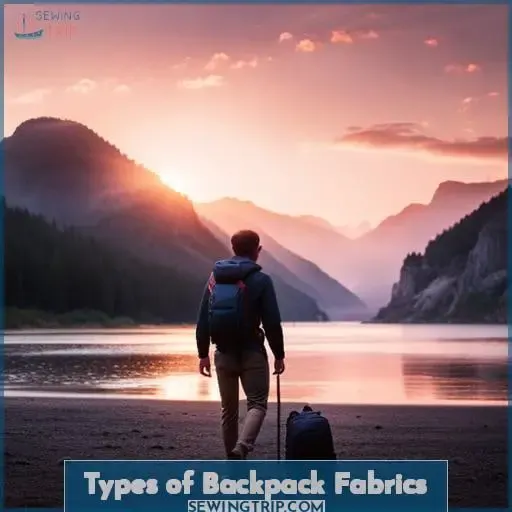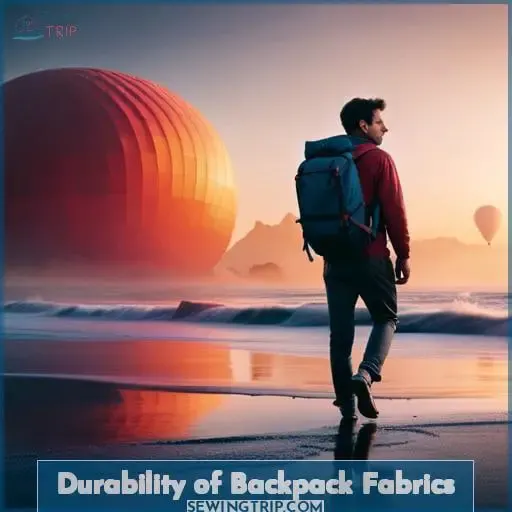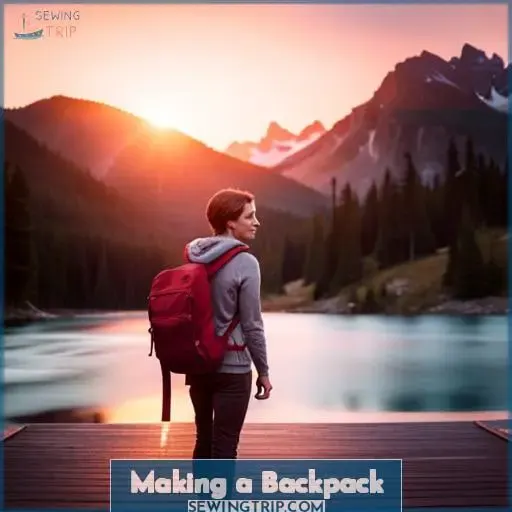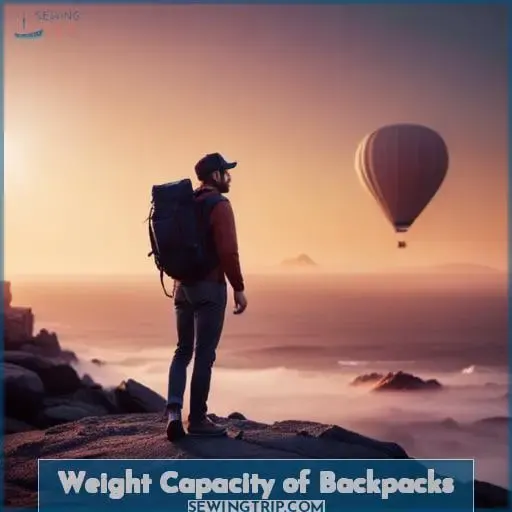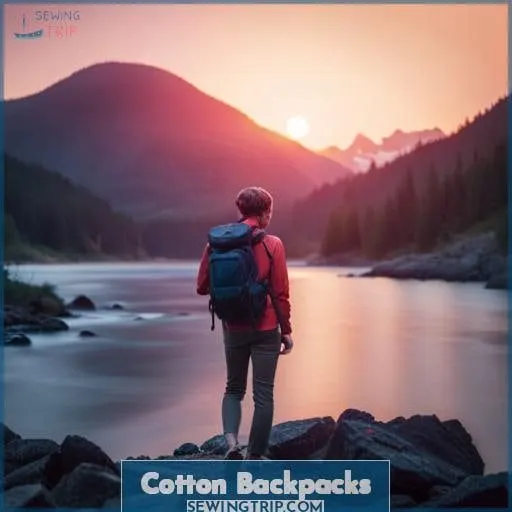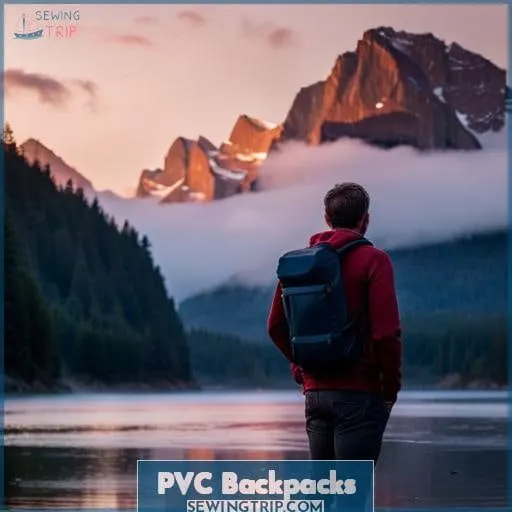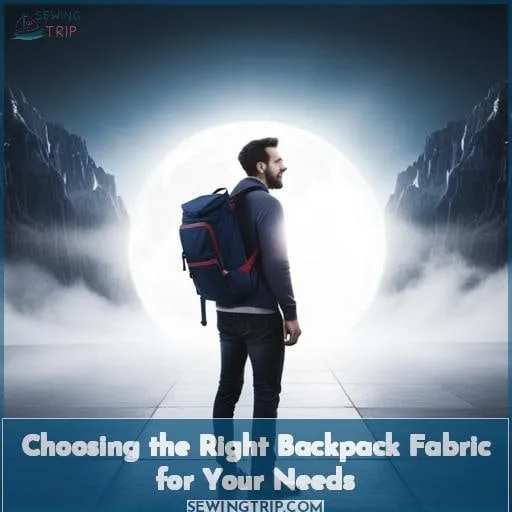This site is supported by our readers. We may earn a commission, at no cost to you, if you purchase through links.
 A backpack can be a symbol of freedom, understanding, and safety. It’s the perfect companion for any traveler or adventurer as it allows them to carry their belongings with ease.
A backpack can be a symbol of freedom, understanding, and safety. It’s the perfect companion for any traveler or adventurer as it allows them to carry their belongings with ease.
There is an extensive range of fabrics that can be used when making a backpack; from cotton canvas to leather, denim to PVC – there’s something for everyone! In this article, we explore 9 different materials commonly used in backpacks so you’ll have all the information needed to choose one that suits your unique needs and preferences.
We will also look at how these fabrics affect durability, weight capacity, and factors you should consider before buying a new bag – get ready for some serious research on what fabric backpacks are made out of!
Table Of Contents
Key Takeaways
- Backpacks can be made from a variety of materials, including cotton canvas, leather, denim, PVC, nylon, Cordura, rip-stop nylon, and polyester pack cloth.
- When selecting a backpack, it is important to consider factors such as durability, weather resistance, weight capacity, comfort, size, and the number of pockets.
- Proper care and maintenance of a backpack, such as regular washing and leather conditioning, can help extend its lifespan.
- Environmental impact should also be considered when selecting a backpack material, as some materials like polyester and nylon may not be biodegradable and can be hazardous if not recycled properly.
Types of Backpack Fabrics
You may have heard of cotton canvas, nylon, leather, denim, and PVC as backpack materials. But do you know what makes each fabric suitable for backpacks? What are their advantages and drawbacks? In this article, we’ll look at the pros and cons of these popular fabrics so that you can make an informed decision when choosing a backpack.
Cotton Canvas
You’ll love the stylish, sturdy look of cotton canvas – perfect for a professional image that will stand up to years of use. Cotton backpacks offer great style and durability but come at a price and can be less breathable than other materials.
It is popular amongst those who want an on-trend personal style as well as practicality in their bags.
Care needs to be taken when using paper templates of each backpack part due to its tendency to rot if stored incorrectly over time. Polyester pack cloth may also provide more benefits than cotton canvas due to its high resistance to UV degradation, though it isn’t quite as strong overall or stylish looking! While there are some disadvantages associated with this fabric, its popularity remains thanks mostly to how fashionable yet reliable it is compared with other material options available today.
Nylon
Nylon is the go-to material for backpacks, offering superior durability and waterproofing without sacrificing style. It needs to be treated with PVC or polyurethane coating or silicone for mildew prevention.
Its rip-stop nylon variant has a grid pattern of threads sewn closely together to resist tearing. Additionally, its UV resistance makes it suitable even in sunny environments. Nylon packs offer great value when compared with alternatives like cotton canvas due to their light weight yet high strength properties, which can hold up over time given proper care and handling.
Tear resistance and flame retardancy are other features that make this an ideal fabric choice for packs.
Leather
Leather backpacks offer a sophisticated look and feel, like owning your own little luxury briefcase. They are usually made from real leather to ensure durability and longevity of the product. Their high-quality design also guarantees an attractive style that is hard to replicate with other materials or fabrics.
Leather bags require special care to last longer. They need regular cleaning and conditioning, as well as protection from extreme weather conditions such as rain or sun exposure. Despite being heavier than nylon fabric backpacks, their abrasion-resistant properties make them ideal for carrying heavy items on a daily basis without sacrificing fashion sense.
Although treated fabric options may be cheaper in price but low in quality compared to authentic leathers, nothing beats the classic appeal of investing in one genuine piece that can stand the test of time with proper maintenance over time!
Denim
Carrying around a denim backpack gives you an edgy, cool vibe that will make heads turn. These bags are fashionable and affordable, made from heavy-duty fabric with careful stitching to ensure durability.
While not as waterproof as nylon or leather backpacks, denim bags can hold up against normal wear and tear without discoloring over time.
Putting together the perfect backpack is like putting together one giant fabric puzzle. There’s no one right answer! Denim is just one of many materials available, each requiring special care to last longer.
PVC
PVC is an economical choice for your backpack. It is waterproof and tough enough to take a beating. However, it is not as strong as nylon, so it requires special care to ensure longevity. PVC fabric resists discoloration better than cotton canvas or denim and offers a range of colors from bright neon hues to classic blacks that will match any outfit.
A well-made backpack using PVC material could last you years if cared for properly. However, it can get dirty easily and should be wiped down regularly with mild soap or cleaning solution.
Today, cotton canvas was the go-to option before women’s fashion backpacks became popular in recent years due to its lightweight quality yet superior durability compared with other materials like polyester pack cloth which has high resistance against UV degradation but isn’t quite as strong when faced with abrasive conditions.
Choose wisely by considering all options available, including various types and colors of PVC fabric offered by PacCana on their website!
Durability of Backpack Fabrics
You want your backpack to be tough and durable, so you should know the difference between Cordura, Rip-Stop Nylon, and Polyester Pack Cloth. All three fabrics are popular choices for backpacks, but they have different properties that make them suitable or unsuitable for certain conditions.
Cordura
Cordura is a heavy-duty material that’s built to last, perfect for those who need an extra durable backpack. It’s abrasion and water-resistant, making it ideal for outdoor activities or everyday use.
The individual pieces can be sewn together to create custom designs, while giant rolls of fabric are available in multiple colors and patterns. Cordura backpacks require special care due to their sensitive nature, but when given proper maintenance, they can last years longer than other fabrics such as leather or nylon.
The benefits of Cordura include being lightweight yet strong enough to carry heavier items without tearing, as well as being able to withstand wear from daily activities like hiking or commuting on the subway.
Choosing a backpack made out of Cordura will help prevent pain in your neck and shoulders by distributing weight evenly throughout your body, so you don’t experience discomfort during long trips away from home.
Rip-Stop Nylon
Rip-Stop Nylon is a great choice for those seeking an extra durable backpack. Its grid pattern of threads sewn closely together resists tearing and UV degradation. It’s also lightweight, so you won’t experience neck or shoulder pain when carrying your belongings around.
For continuous exposure in the outdoors, it’s best to treat untreated nylon with a waterproof coating such as PVC or polyurethane. However, this may cause mildew over time if not properly cared for. The fabric is strong enough that even lightweight nylon will hold heavier items without ripping compared to other fabrics such as leather and cotton canvas, which are more prone to wear down from regular use.
When selecting the right fabric type, factor in durability, style preferences, and what size/weight capacity is needed so you can make the most informed decision possible!
Polyester Pack Cloth
Polyester pack cloth is a great choice if you’re looking for durability and UV resistance in your backpack. It’s strong enough to hold heavier items without tearing. Waterproofing helps protect its contents from the elements, and it won’t suffer dye bleed over time like cotton canvas.
This fabric also provides added tear-resistance compared to other fabrics such as leather or nylon, which are more prone to wear down with regular use.
Making a Backpack
Creating a backpack requires more than just picking out the right fabric; it also involves precision cutting, pressing, and molding of the fabric, stitching each piece together with care, and adding buckles or other details.
All of these steps come together to make a sturdy bag that is sure to hold up against whatever you throw at it! So, if you’re looking for something durable yet stylish, take some time to consider which fabrics will suit your needs best before beginning this journey into creating your own backpack.
Cutting the Fabric
Once you’ve decided on the fabric, it’s time to get cutting! Choosing the right fabric is key for a successful backpack. Fabric quality and choice can make or break a project, so take your time when selecting what type of material will best suit your needs.
You’ll need some specialized tools like scissors or shears depending on the thickness of the material. Consider how sewing techniques may affect stitching details with different fabrics as well as outdoor use.
If you have access to a sewing machine, this could be an easier way instead of hand-sewing if necessary.
Working with such wonderful materials that are similar in early backpacks makes crafting them fun and rewarding once complete!
Pressing and Molding the Fabric
After selecting the right fabric for your project, it’s time to press and mold it for shape. You may need to consider different molding techniques depending on the type of fabric you choose.
Fabric selection is key when looking at durability testing as well as material testing in extreme weather conditions like a wet day or high temperatures. To ensure higher quality, some backpack makers opt for cellophane wrap, which offers protection against water penetration and keeps dirt away from front pocket zippers.
There are a ton of options available when making backpacks, so make sure you research thoroughly before selecting one! Quality fabrics, such as Cordura nylon, offer superior strength with minimal weight, so be mindful when choosing what works best for your needs.
Sewing the Fabric
You can create a strong, reliable, and stylish backpack by carefully sewing the fabric. Threading your machine with the right thread and needle size is essential to achieve durable seams that won’t break apart over time.
Fabric selection plays a huge role in determining which type of stitch you should use for each section of your backpack.
Trimming seams and stitching details will give your bag a professional look, while lining pockets adds functionality. Remember to keep body weight in mind when designing your pack, as comfort is essential today.
| Sewing Tips |
|---|
| Use appropriate thread & needle size |
| Choose stitches based on fabric selection |
| Trim seams & add stitching detail for professionalism |
| Add lining pockets for functionality |
Adding Buckles and Details
Personalize your backpack with buckles and details for a truly unique look. Attaching buckles to waterproof materials will help protect the contents inside the bag. Fabric selection can affect comfort levels when carrying it. Selecting the right size of a backpack is important because you don’t want it to be too big or small.
It should also last a long time. Consider investing in quality materials, which may cost more but will pay off in the end. When packing, keep the weight at 10% of body weight, placed evenly across the base of the pack for balance and stability.
That’s where adding extra straps comes in handy! The downside to treated fabrics is they are less breathable than untreated ones, but much more resilient against water damage over time if properly maintained.
Bringing the Pieces Together
Now, bring it all together by securely stitching the components of your backpack for a lasting and stylish design. Select the right fabric carefully as it impacts comfort levels when carrying much weight.
Recent customer trends should be taken into consideration to achieve a stylish look. Customization options, such as extra straps, can help distribute weight evenly while providing additional support.
Weight Capacity of Backpacks
When selecting a backpack, consider the weight capacity to ensure it can handle your belongings safely. The carrying capacity of a backpack is generally determined by the strength and durability of its material.
Backpacks made from cotton canvas or nylon are usually able to hold up to 30-40 pounds before they risk tearing. On the other hand, leather backpacks have been known to hold far more weight, but at an expensive price tag and cumbersome size that could make them difficult for some people to carry around comfortably.
To maximize safety when packing your bag with items, look for waterproof materials such as polyester that won’t be affected by temperature changes or discolored over time due to sun damage.
PVC fabric is cost-effective and highly durable, with the only flaw being that dirt easily accumulates on it.
With careful consideration during the selection process, you’ll end up with the perfect combination of function and style, making the interesting process even easier than expected!
Factors to Consider When Buying a Backpack
When shopping for a backpack, it’s important to consider several factors in order to make sure you get the best product.
Take weight tolerance into account – make sure that your bag of choice can handle the amount of items you plan on carrying without tearing or becoming too heavy.
Comfort is also key. Look for an adjustable strap and padding so that your shoulders and back don’t suffer from strain while wearing it.
Size-wise, a good backpack should not be too big or small as this will affect its usability.
Additionally, check how many pockets are included. Having organized compartments allows for easy access when needed!
Finally, protection against weather conditions such as rain or sun damage should always be taken into consideration when selecting fabrics like polyester and PVC fabric respectively.
Weight Tolerance
You’ll want to make sure that the backpack you choose can handle the weight of your belongings comfortably. Consider ease of cleaning, resistance to sun damage and temperature sensitivity, prevention of dye bleeding, and waterproofing when selecting a material.
Nylon is durable and waterproof but needs special coatings for protection. Polypropylene is lightweight yet long-lasting. Cotton canvas may be stylish but expensive. PVC fabric resists tears at a low cost while leather looks professional but heavy.
To protect yourself from potential injuries due to overloading your bag with items, consider opting for fabrics specifically designed by PacCana.
Comfort
Choosing the right fabric for your backpack can make all the difference in terms of comfort and ease of carrying. Nylon is waterproof but must be treated for protection against weather damage. Polypropylene is lightweight yet durable enough to carry weight comfortably.
Cotton canvas may look stylish, but it’s expensive and not as breathable as nylon or polypropylene. PVC fabric resists tears at a low cost – perfect if you’re looking for an affordable option that still has durability and strength when carrying items inside your bag! Leather backpacks have a professional look; however, they are cumbersome to carry around due to their heavier weight compared to other fabrics like nylon or cotton canvas.
Size
Choose a backpack that provides ample space for your items without being too bulky or heavy. The size of the bag may impact its comfort and overall function, so consider factors such as weight capacity, fabric quality, and style choices when selecting a backpack.
Comfort level is key, so opt for lightweight materials like nylon or polypropylene to make carrying easier on you. Size limit matters too, so be sure to choose one that won’t strain your shoulders but still has enough room to accommodate all of your belongings safely.
Number of Pockets
You can easily organize your items with a backpack featuring multiple pockets. Different pocket styles, locations, sizes, and materials offer more options for organization. Choose from different pocket shapes to suit the needs of specific items or activities you’ll be carrying out.
For example, large square pockets are great for bulky items like books, while slim rectangular ones make it easier to store pens and pencils securely in place without taking up too much space inside the bag.
With so many options available, there’s no need to sacrifice convenience when picking a backpack!
Protection
Protecting your items is an important factor to consider when selecting a backpack.
Look for backpacks with UV resistance, comfort level, waterproofing, fabric durability, and aesthetic appeal to keep your belongings secure. Fabrics like Cordura are rugged and water-resistant, while nylon offers the most durable protection against tears but needs special treatment for full waterproofness.
Polyester packs are flexible yet sensitive to temperature changes, while polypropylene is long-lasting but may discolor over time from sun exposure.
Choose wisely so you’ll have peace of mind knowing all your possessions will remain safe!
Cotton Backpacks
Carrying a cotton backpack is a great way to showcase your style while ensuring durability and comfort. Cotton backpacks are known for their sturdiness, making them perfect for carrying everyday essentials or going on outdoor adventures.
The quality of the cotton used in the manufacturing process determines its strength and longevity, so it’s important to choose high-quality options that will stand up against wear and tear.
In terms of care, cotton is easy to clean with basic washing techniques but can be susceptible to shrinking if not washed properly. There are various styles available such as drawstring bags or classic zippered designs which come in different colors and patterns at varying price points depending on the brand name or designer label attached.
| Pros | Cons |
|---|---|
| Durable | Expensive |
| Comfortable | Less breathable |
| Stylish |
PVC Backpacks
PVC backpacks are becoming an increasingly popular choice for those looking to bring style and function together. These affordable bags provide a great way to carry your items without breaking the bank and are popular in modern fashion.
PVC fabrics offer waterproof protection and can be printed with vibrant colors, making them stand out from other materials like cotton or nylon. They’re also easy to clean and maintain, making it simple for you to keep your bag looking its best over time.
Despite their benefits, there are some considerations when using this material. For example, discoloration may occur after long periods of exposure to sunlight, and heat damage may occur if stored improperly.
However, following care instructions should minimize any potential issues that may arise with regular use of PVC backpacks.
To get the most out of a backpack made from this fabric, consider trends such as bright neon hues, eye-catching patterns like animal prints, or digital designs that will help make your bag stand out in any crowd while still being practical enough for everyday adventures!
Choosing the Right Backpack Fabric for Your Needs
When selecting a stylish and sturdy backpack, consider the comfort level of different fabrics and their durability against wear and tear. Functionality should be your priority. Pick materials that are lightweight yet strong enough to hold everything you need.
Nylon is waterproof and tear-resistant, while polyester provides flexibility but may suffer from sun damage over time. Leather has a professional look but requires special care when cleaning or storing it away.
PVC is cost-effective and easy to clean, but not as durable as other options like cotton canvas or Cordura, which can handle heavier loads without tearing apart easily.
Frequently Asked Questions (FAQs)
What is the best type of fabric for a backpack?
The best type of fabric for a backpack depends on your needs. Nylon is highly durable, waterproof, and resistant to tears. Leather looks professional but requires special care. Denim is stylish and affordable, while PVC backpacks are cost-effective and waterproof.
Polyester offers flexibility, while polypropylene is easy to clean yet sensitive to sun damage.
Are there any environmental considerations when choosing a backpack fabric?
Choosing a backpack fabric with environmental considerations in mind is important. For instance, polyester and nylon are both petroleum-based synthetic materials, making them non-biodegradable and potentially hazardous to the environment if not recycled properly.
PVC can also be toxic when manufactured or disposed of incorrectly. Consider natural fabrics like cotton canvas as an eco-friendly alternative that will last for years without negatively impacting the environment.
Are there any health considerations when carrying a heavy backpack?
Carrying a heavy backpack can cause pain in your back, neck, and shoulders. To avoid this, limit the weight to only 10% of your body weight. Wearing it correctly can help too – make sure straps are tight and centered on your back for even distribution of the load.
How often should I wash my backpack?
To keep your backpack in top condition, it should be washed regularly. Allusions to the material can give an indication of how often it should be washed; leather and cotton may need more frequent cleaning than nylon or polyester backpacks.
What special care is required for leather backpacks?
Leather backpacks require special care. They need to be regularly cleaned and conditioned with a leather protector.
Conclusion
To sum it up, it’s important to consider the type of fabric and weight capacity of a backpack when making a purchase. Cotton backpacks are stylish but may not withstand heavy loads, while nylon is durable and waterproof.
PVC is cost-effective and waterproof, but may not be as long-lasting. Polyester and polypropylene backpacks are lightweight and flexible, but it’s important to check the strength of the fabric. Cordura is almost indestructible, but much heavier than other fabrics. Finding the right combination of strength, weight, comfort, and style is a balancing act.
Don’t forget to research before investing in a backpack; it’s an investment that will pay off in the long run.

